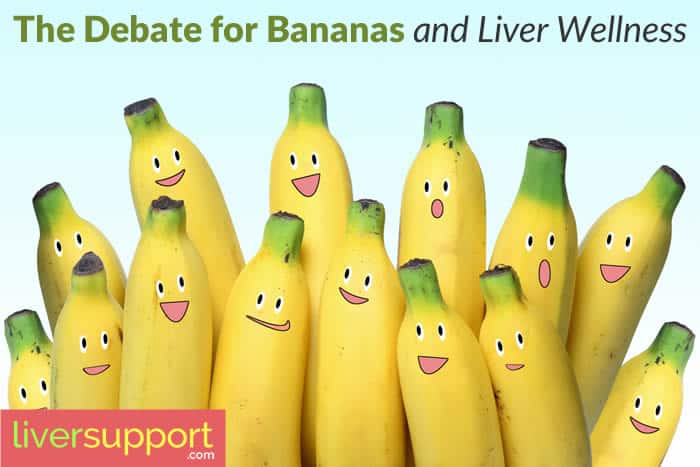
Previous
10 Medications to Be Wary of With Liver Disease

Next
Is Bubbly Water Good for Your Liver?
The Debate for Bananas and Liver Wellness
As long as you consider the banana guidelines described below, this popular fruit could be a great addition to your plan for optimal liver health.
Those with chronic liver disease know that everything they eat or drink has an impact on their liver’s health. The effect can be minor or dramatic, depending on the quantity of functioning liver cells and where your food or drink ranks on the liver wellness scale. Being a fruit with a compelling nutritional profile, there is some debate regarding where bananas fall on the continuum of liver wellness.
Bananas’ Bad Rap
Bananas are often on the receiving end of critics denouncing this fruit’s healthfulness. This is primarily because for fruit, bananas have a relatively high sugar and starch content. While a diet rich in fruits and vegetables has been consistently shown to prevent weight gain, certain fruits (like bananas) are not exactly a low sugar food. All fruit contains sugar, but bananas – especially overripe ones, contain more than most others:
- Over 90% of the calories in bananas come from carbohydrates.
- As the banana ripens, the carbohydrates turn into sugar.
- Unripe (green) bananas are high in starch and resistant starch.
- Ripe (yellow) bananas contain more sugar than starch.
3 Reasons to Overlook Bananas’ Bad Rap
Yes, a ripe banana has about 14 grams of sugar. That is approximately equivalent to three and a half teaspoons of granulated sugar. However, bananas are also fat-free, cholesterol-free and sodium-free – and they are loaded with nutrients that benefit your liver:
- Potassium – One medium-sized banana contains 422 milligrams of potassium. A low sodium diet is essential to lowering blood pressure, but increasing potassium intake can be just as important due to its vasodilation effects. According to the National Health and Nutrition Examination Survey, fewer than two percent of U.S. adults meet the daily 4,700 mg potassium recommendation. Potassium helps maintain fluid levels in your body and regulates the movement of nutrients and waste products in and out of cells. For a liver that is challenged with fibrosis or cirrhosis, vasodilation and fluid regulation help reduce congestion and promote health. Although your liver doesn’t process potassium, a severe lack of potassium can disrupt its function.
- Resistant Starch – Green bananas contain resistant starch, a starch that acts like soluble fiber and escapes digestion. Resistant starch helps moderate blood sugar levels after meals, and reduces appetite by slowing stomach emptying. For those trying to prevent or reverse fatty liver disease, blood sugar level moderation and appetite reduction are both helpful for maintaining a healthy weight (a major deterrent for liver fat accumulation). The good news is most liver issues can be reversed if caught early enough. Not only does Clinical LiverSupport help reduce fat accumulation in your liver, it was also developed to nourish, support and provide comprehensive protection for your liver and to help produce new healthy liver cells.
- Fiber – One banana has about 3.1 grams of fiber. A healthy diet for fatty liver disease should include fruit, because of its high amount of dietary fiber. According to the University of Rochester Medical Center, high cholesterol, diabetes or high blood pressure can lead to fatty liver disease or complications from it. Fiber lowers your cholesterol levels, and it may help regulate your blood sugar levels to prevent or control Type 2 diabetes.
Glycemic Index
The ranking of bananas on the glycemic index gives us more information on the effect banana consumption has on your blood sugar. Bananas rank low to medium on the glycemic index – a measure from 0 to 100 of how quickly foods increase blood sugar levels. The closer to 100, the faster blood sugar levels rise, which puts cells at risk of becoming insulin resistant, priming the way for diabetes and fatty liver disease.
The glycemic index value of unripe bananas is about 30 – while ripe bananas are about 60. Average bananas have a glycemic index of 51 – meaning that they do not cause a major spike in blood sugar levels in those with cells that respond normally to insulin. However, diabetics must monitor blood sugar carefully and are typically advised to avoid eating lots of very ripe bananas.
When looking at the big picture, bananas are a great choice for those with liver concerns. They are ideal when trying to maintain or lose weight because they are nutritious, filling and help lower appetite. The nutrients that bananas are high in (resistant starch, potassium and fiber) and those missing from their nutritional profile (fat, cholesterol and sodium) means that they fare relatively high on the liver wellness scale. Because bananas are sweet (contain sugar), they are to be consumed in moderation. Thus, one or two a day is plenty! In addition, choose under-ripened bananas (closer to a light green than dark yellow) for a sweet treat that scores higher on the liver wellness scale.
https://authoritynutrition.com/11-proven-benefits-of-bananas/, 11 Evidence-Based Health Benefits of Bananas, Adda Bjarnadottir, MS, Retrieved July 14, 2017, Authority Nutrition, 2017.
https://authoritynutrition.com/bananas-good-or-bad/, Bananas: Good or Bad?, Hrefna Palsdottir, MS, Retrieved July 16, 2017, Authority Nutrition, 2017.
https://draxe.com/liver-disease/, Natural Ways to Treat Liver Disease, Retrieved July 11, 2017, DrAxe.com, 2017.
https://greatist.com/health/sugar-wise-how-fruits-stack, Sugar Wise: How Fruit Stacks Up, Caitlin Covington, Retrieved July 16, 2017, Greatist, 2017.
http://www.cirrhosis-treatment.net/fruits.html, Fruits Recommended For Patients with Liver Cirrhosis, Retrieved July 11, 2017, cirrhosis-treatment.net, 2017.
http://www.cnn.com/2014/01/15/health/bananas-nutritional-benefits/index.html, Are Bananas Bad for Me, Too?, Jacque Wilson, Retrieved July 11, 2017, Cable News Network, 2017.
http://www.livestrong.com/article/542651-fruit-fatty-liver/, Fruit and Fatty Liver, Natalie Stein, Retrieved July 11, 2017, Livestrong.com, 2017.
www.medicalnewstoday.com/articles/271157.php, Bananas: Health benefits, facts, research, Megan Ware, RDN, LD, Retrieved July 14, 2017, Healthline Media UK, Ltd, 2017.
http://www.webmd.com/food-recipes/features/sugar-shockers-foods-surprisingly-high-in-sugar#1, Sugar Shockers: Foods Surprisingly High in Sugar, Elaine Magee, MPH, RD, REtreived July 16, 2017, WebMD, LLC, 2017.






